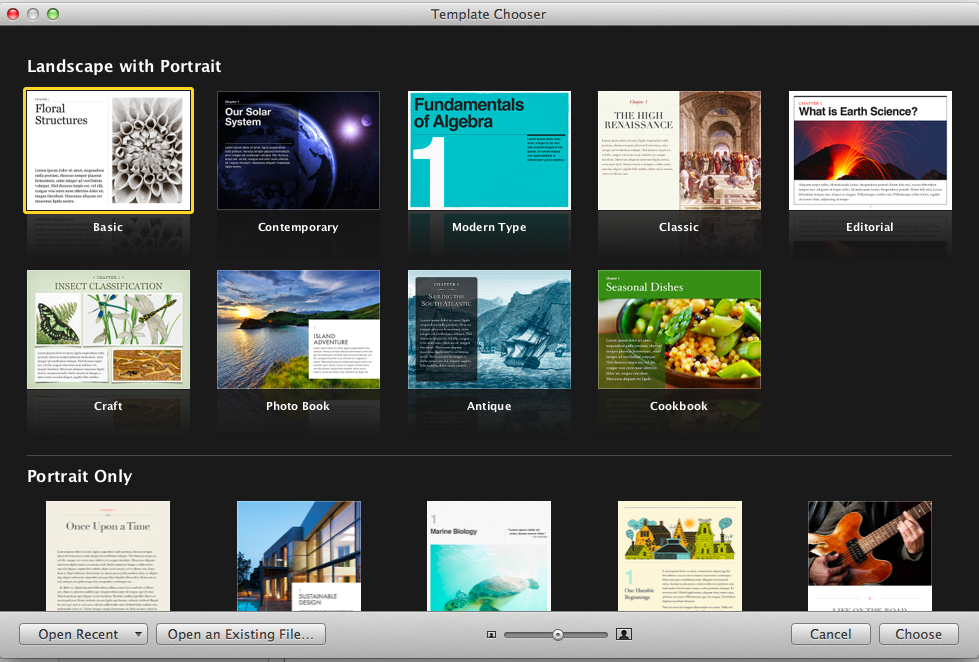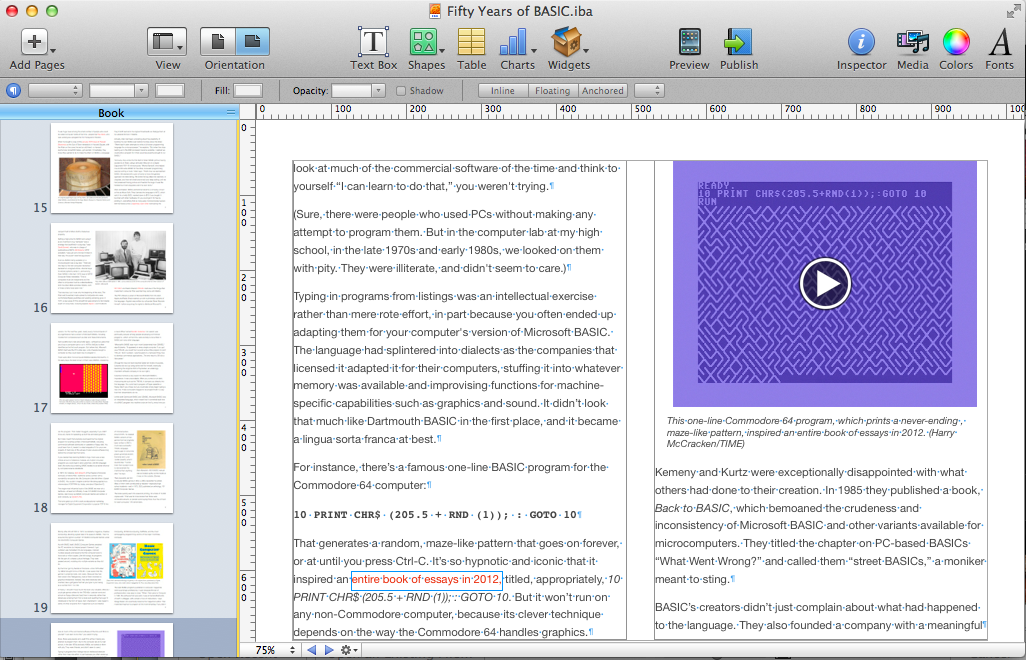
What is Apple’s iBooks platform?
The most obvious way to answer that question is to say that it’s the company’s equivalent of Amazon’s Kindle. And it is–they both offer online stores for buying digital tomes, and apps for reading them.
But merely likening iBooks to Kindle isn’t a very satisfactory way of explaining it. For all the similarities between them, their differences are at least as striking.
Kindle is about e-books anywhere and everywhere: On Amazon tablets, iPhones, iPads, Android phones and tablets, Windows Phones, Windows PCs and, most likely, any future devices with even the slightest bit of market traction. iBooks, by contrast, can only be read on Apple hardware: iPads, iPhones and Macs.
But Apple being Apple, iBooks is visually sumptuous–especially in the case of “Made for iBooks” books, which work only on the iPad and Mac versions of iBooks, not on the iPhone one. Such titles are created with a Mac program called iBooks Author, which lets you design stylish books that incorporate images, video, embedded web widgets and other trimmings. You can design something that feels a little like a coffee-table book and a little like an app, and then use Apple’s iBookstore to sell it or give it away.
And one of the neatest things about iBooks Author is that it’s a free download from the Mac App Store, designed to be as approachable as a word processor–giving anyone with a yen to publish an interactive book the same tool used by major publishers of textbooks and other titles.
(It’s possible, incidentally, to put together an attractive Kindle e-book–even one that embeds video and audio elements. But many Kindle books, even ones that should be highly visual, are less than gorgeous. For instance, I recently spent $26 for a Kindle book of photographs by Sammy Davis Jr.; the pictures are great, but the thing looks like it was laid out by a fourth grader in a version of Microsoft Word from 1992.)

Apple unveiled iBooks Author in January 2012, at an event in New York that emphasized using it to create textbooks. It’s equally well-suited to other sorts of books that meld multiple types of media, especially ones with an instructional bent. The fact that it’s free, simple and connected to the iBookstore has let real people with something to say reach a meaningful readership, such as the two Afghanistan veterans who produced an engaging book titled Perfect Coffee at Home. (It became the iBookstore’s top cookbook.)
For an Apple product, though, iBooks Author has a low profile. It’s a bit of an outlier among Apple’s productivity apps, neither part of the iLife creativity suite (which includes programs such as iPhoto and iMovie), nor the iWork office suite (which includes the Pages word processor, Numbers spreadsheet and Keynote presentation package). But it’s as Apple-esque as any piece of software the company offers; if you can figure out any of those aforementioned apps, you’ll feel at home in this one.
To try out iBooks Author myself, I wrote and designed a short book. More specifically, I took the longest, most lavishly-illustrated article I’ve written recently for TIME.com–an 8,000-word opus on the 50th anniversary of the BASIC programming language–and turned it into a 29-page iBook. You can download it here.

For the most part, creating my book was a really easy process–one I accomplished over a couple of nights as I watched TV at home. I chose a template that automatically formatted the book for reading in both portrait and landscape orientations on an iPad, poured in the text, and decided where to position the photographs and animated GIFs from the web version. (The program automatically converted the GIFs into short videos.)
Working in iBooks Author feels a little like using Pages and a little like using Keynote. Other than pulling together the text and images and plopping them where I wanted, most of the effort on my end involved cleaning up the text here and there, such as making sure that all the imported quotation marks were curly quotes rather than plain straight ones. Every so often, I previewed my work in process by looking at it on my iPad–which, once you’ve connected the tablet to your Mac via USB, is a snap.

The only part of the process that felt balky was getting columns of text to line up neatly: Sometimes they were uneven and I couldn’t nudge them into alignment. (I’ve noticed this to be an issue with some of the Made for iBooks titles I’ve downloaded from the iBookstore, too.)
Because my BASIC book was an experiment rather than a commercial product, I didn’t submit it to the iBookstore; if I had done so, it would have gone through an approval process akin to the one in place at Apple’s App Store. But you don’t need to use the iBookstore to get your works in front of readers, since you can also send iBooks files by e-mail or put them on websites.

Which brings up another point that needs mentioning. Shortly after Apple announced iBooks Author, a kerfuffle broke out over the software’s license agreement. Just as with apps in the App Store, iBooks in the iBookstore can be free or come with a price attached. In the case of for-pay books, Apple collects a fee of 30 percent for distributing your work. None of that was surprising or controversial.
But the the catch is that the iBooks Author license agreement stipulates you can only charge for a book in iBooks format when you distribute it through Apple’s store, not if it’s available elsewhere. Basically, if anyone is making money off an iBook created with iBooks Author, Apple wants a cut.
That part, some people were very unhappy about. They tended to look at it as being equivalent to Microsoft demanding a fee whenever someone used Word to write something profitable.
I’ve wrestled with my feelings about the rule myself, and have concluded that I don’t find it all that bothersome. For one thing, you can output an iBooks Author file in PDF format; it will lose its video and interactive features, but you can do whatever you want with it, including selling it for money wherever you like. Even more than that, though, the fact that iBooks Author’s books only work on iPads and Macs means that if I invested a lot of effort in creating an e-book, I’d probably want to make it available in a non-iBooks version anyhow–which would give me options for monetizing it beyond the iBookstore.
It’s also hard to imagine that anyone’s going to come up with a better way to sell iBooks than the iBookstore, which has the advantage of being deeply integrated with the iBooks apps on millions of Apple devices.
Ultimately, the proposition Apple is offering–powerful and elegant free authoring software, plus a way to get the things you create with it in front of vast numbers of people–seems like a reasonable deal to me. The next time I have an idea that feels like it might be a book, I may well decide to turn it into an iBook.
More Must-Reads from TIME
- Cybersecurity Experts Are Sounding the Alarm on DOGE
- Meet the 2025 Women of the Year
- The Harsh Truth About Disability Inclusion
- Why Do More Young Adults Have Cancer?
- Colman Domingo Leads With Radical Love
- How to Get Better at Doing Things Alone
- Michelle Zauner Stares Down the Darkness
Contact us at letters@time.com